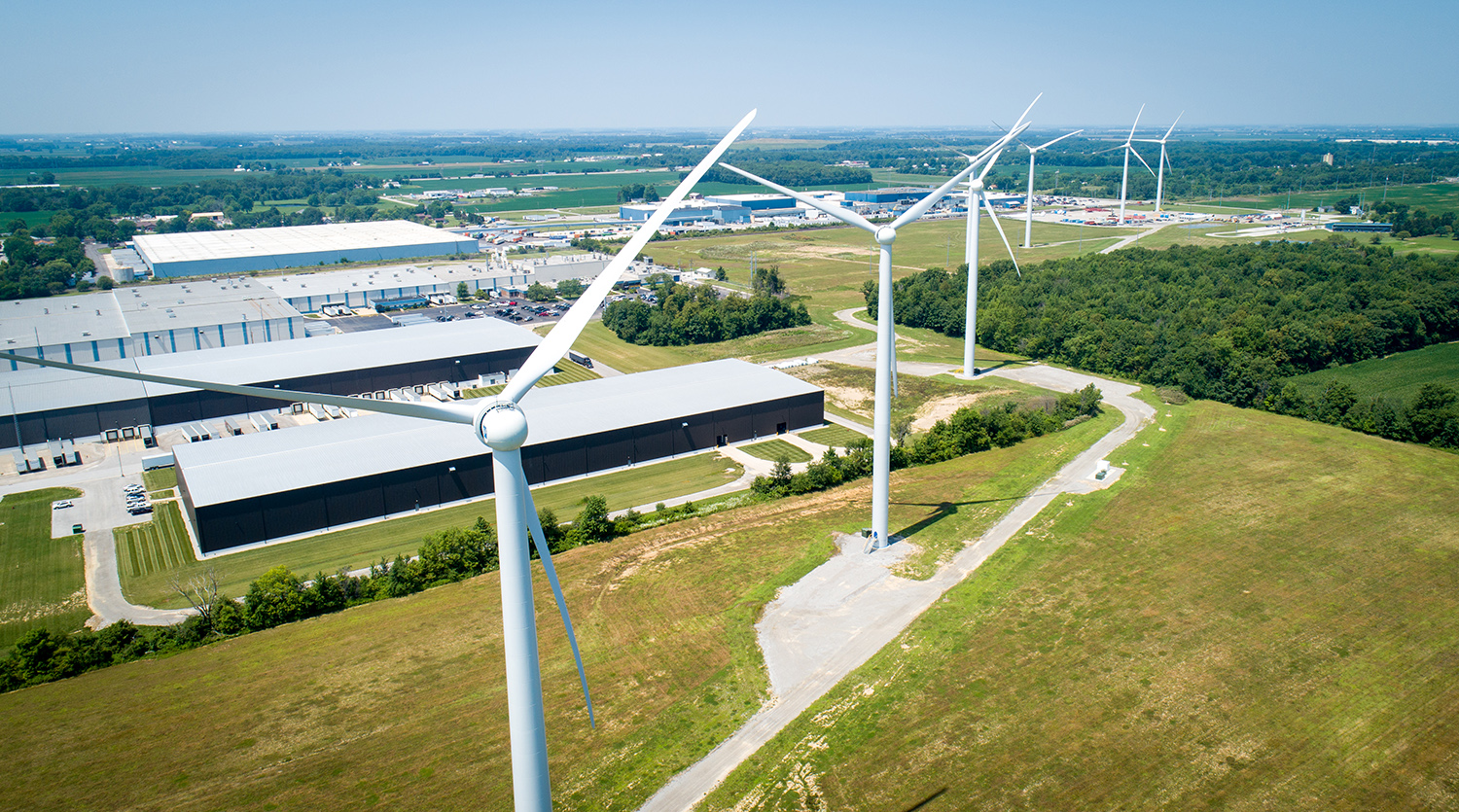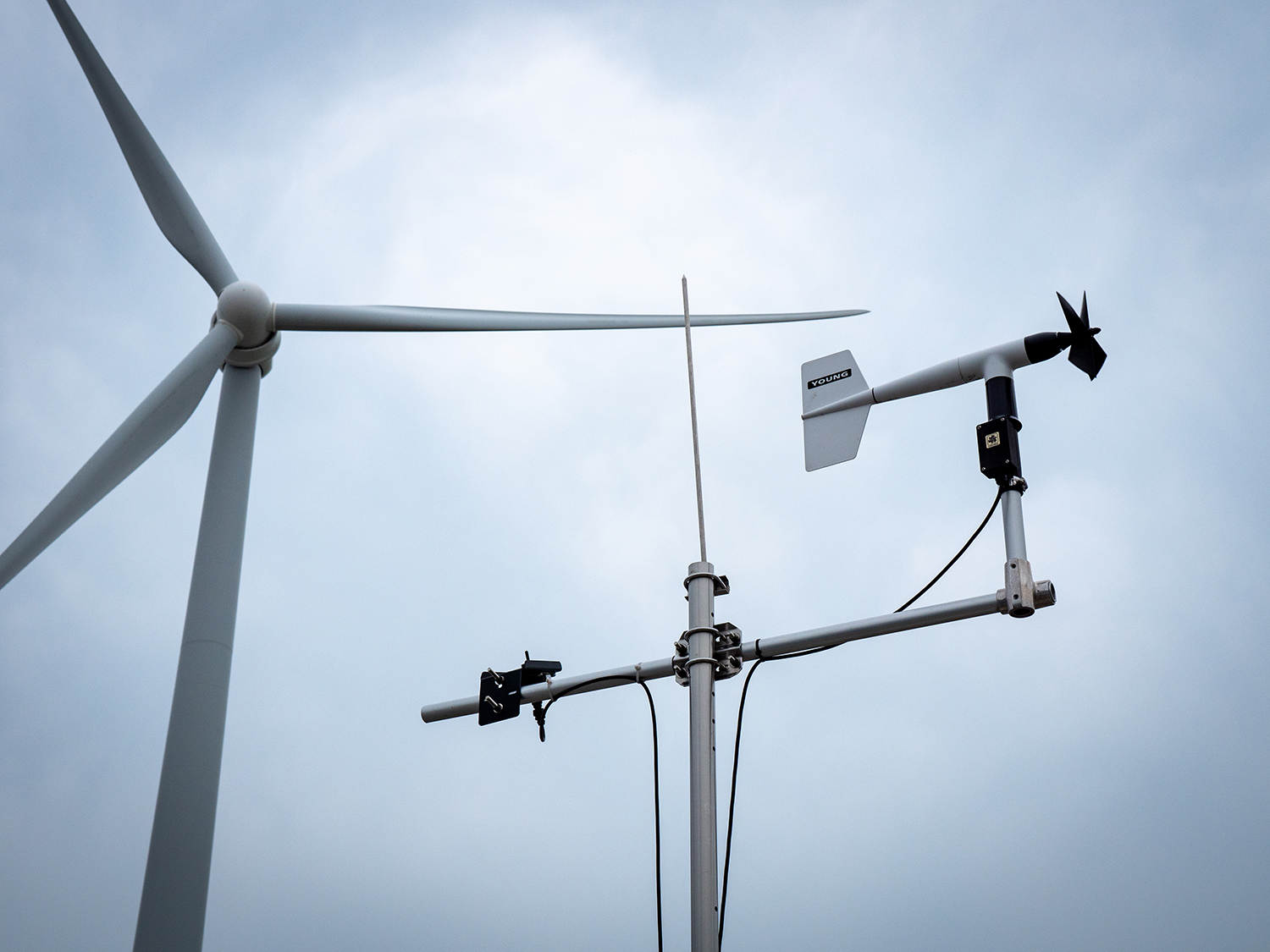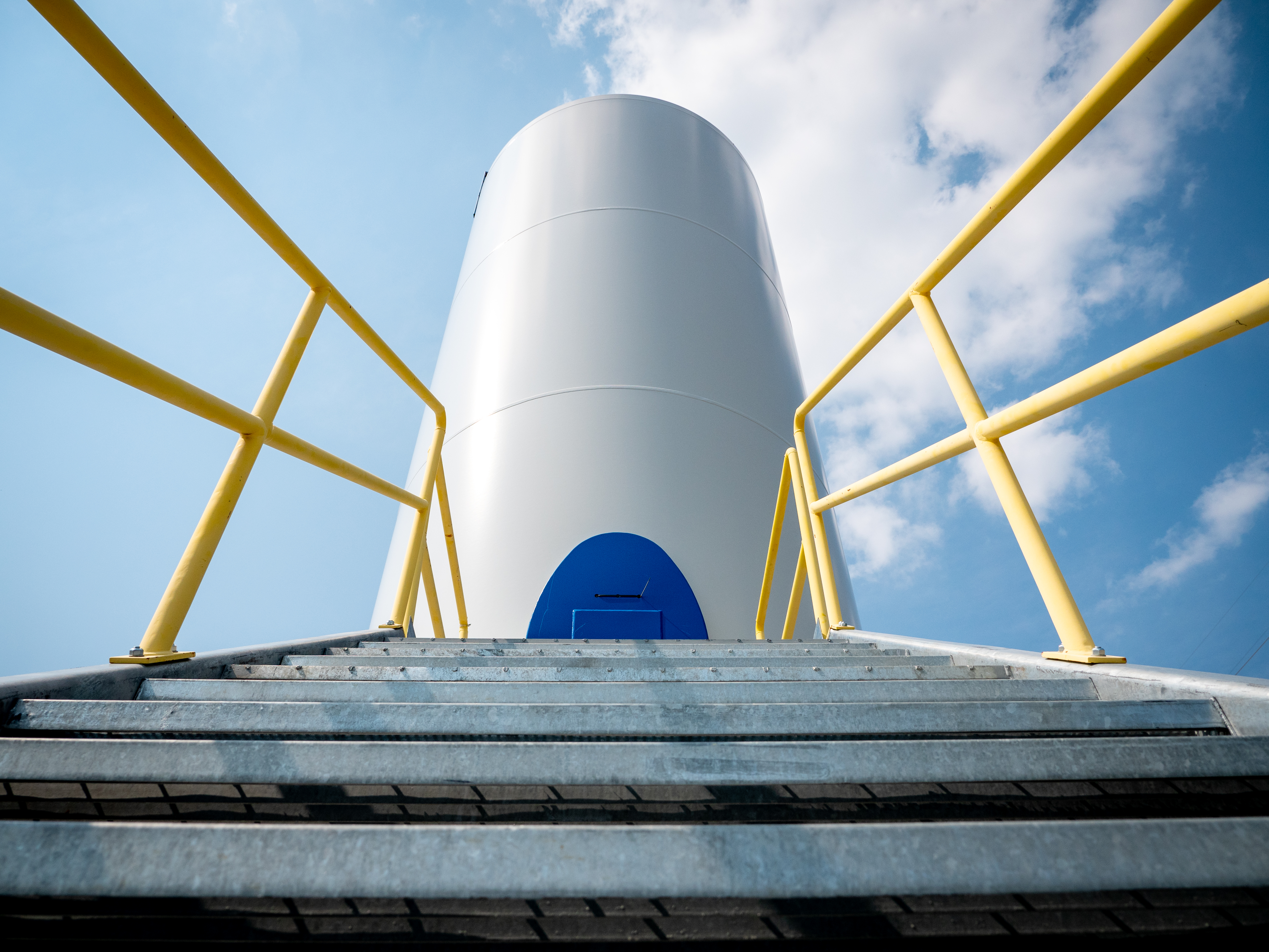SITE PATH
ONE ENERGY FEED

SUBSCRIBE
CONNECT WITH US
News Filters

Installing a Wind for Industry project represents a major commitment to the community where the project is built. Not only do these turbines directly supply clean energy to the industrial facilities they power, each turbine also has a $5,000 scholarship associated with it, annually awarded to local students pursuing a degree in a STEM field. That’s at least $100,000 in scholarships per turbine throughout its operating lifetime!
What’s more, these turbines are expected to last more than 20 years – so the installation of a Wind for Industry project on site demonstrates a company’s commitment to operating the facility – and continuing to provide local jobs – for decades to come.

As part of Bizwomen’s “In Her Own Words” series, One Energy’s Head of Regulatory Affairs Katie Johnson Treadway wrote about persistence in the time of COVID-19 – as both a mother and an executive in an essential industry. Her essay includes advice on how to face challenges in the pandemic and beyond.

There are many ways to determine which direction the wind is blowing. Some prefer to lick their finger and hold it up in the air. At the One Energy office, we like to look out of our windows to see how the North Findlay Wind Campus turbines are facing. But we also employ more scientific methods to study wind direction and speed, which require wind instruments like the anemometer and wind vane pictured in today’s Wind View!
These instruments collect data on wind speed and direction so we can model weather patterns over a few hours, months, or years. You can learn more by watching our Science Shorts video about OE’s weather station, as well as the episode titled “How Wind Instruments Work.”


Position, velocity, and acceleration – what do these terms really mean? (And perhaps more importantly, what do they have in common?!)
These three properties are part of something called “kinematics” – the branch of physics that helps us describe the laws of motion.
You can learn all about it in today’s Science Short, where Ramy breaks down each term, with helpful examples along the way!
Subscribe to our YouTube channel and don’t miss any future Science Shorts!
And be sure to share this educational series on Facebook and Instagram!

Lately I have heard a lot of discussion about “leader-doers” and the benefits they bring to a company. In fact, just a few weeks ago another member of the executive team at One Energy wrote about this very topic.
So, what are leader-doers? To put it simply, they are people who are responsible for both the functions of a leader, such as managing a team and guiding the strategic vision of the company, and also for completing daily tasks and functions, such as writing reports, creating financial models, and writing contracts.
Many companies have leadership teams that consist of leader-doers, and it can be very beneficial. For example, leader-doers know how to do most of their team’s activities, so they can help employees avoid pitfalls in tasks they are completing. They also tend to be more in touch with the day-to-day experiences of their team and the company.
But not all is rosy when it comes to being a leader-doer. While this leadership style has many benefits, there is a negative underside to the leader-doer; it’s what I call the “leader-do-too-much-er.”
The leader-do-to-much-er has so many daily tasks on their plate that it becomes difficult to both complete those items and have time to manage employees and work on the strategic vision of the company (at least in a timely manner).
There are some serious risks to leaders at a company being leader-do-too-much-ers. First, if a leader has constant deadlines to meet, the urgent ends up taking priority over the necessary or important. This can lead to tasks or big-picture thinking taking a back burner to pressing daily or weekly deadlines.
Second, it can make it increasingly hard to delegate tasks to others. If a leader is so busy getting things done or responding to the urgent matter of the day, it becomes very easy, and sometimes faster, to just complete the task, rather than delegating or training others to take them over.
Third, it can lead to the leader-do-too-much-er slowing down the progress of the rest of the team. If the leader-do-too-much-er has too much on their plate to keep up with the pace that others who have smaller scopes of work, it will drag down the pace of the entire team.
And finally, structuring a company with leader-do-too-much-ers can ultimately cause leaders to burn out. Leaders, like everyone else, can only operate at a high level and intense pace for so long before burnout occurs.
So, what is a company to do? I believe there are three main ways to deal with the issue of the leader-do-too-much-er. First, companies can separate the leaders from the doers. They can have leaders who lead teams and guide strategic vision, but who are not responsible for day-to-day tasks that are core to the functioning of the business. This is probably the simplest way to address the issue of a leader-do-too-much-er, because it creates a clear demarcation in roles and leaves leaders ample time for leading and strategizing. However, the problem with this is that it creates additional overhead and a level of pure “management” that may end up out of touch with employees.
Second, you can have your leadership team be leader-doers, while putting up safeguards to prevent them from becoming leader-do-too-much-ers. This includes looking at the tasks the leader-doer is being asked to complete and trying to determine whether they are reasonable or need to be whittled down or narrowed in scope. It involves taking a hard look at whether other team members can take over some of the tasks of the leader-do-to-much-er. It also includes looking at how much effort the leader-doer must put forth to complete (or attempt to complete) what they are responsible for, and asking yourself, “is this sustainable?”
A third way of approaching the issue is a combination, where some leaders are solely responsible for big picture leadership issues and others are leader-doers.
The second two approaches (establishing safeguards, and a combination of big picture leaders and leader-doers) may enable you to strike the best of both worlds, but they require the hard work and taking the time to evaluate the company’s leadership team and the roles they inhabit. But regardless, at the end of the day, you owe it to your employees and company to put the time and work into guarding against leader-do-too-much-ers. The risks are too high not to.
Katie Johnson Treadway is the Head of Regulatory Affairs at One Energy.

When working hundreds of feet in the air, proper training and safety standards are imperative. If an accident or emergency were to unfold inside a turbine, it is of upmost importance that individuals are returned to the ground safely.
At One Energy, safety and quality are always first – which is why we train and prepare everyone who regularly climbs our wind turbines. From knots to repelling to treatment, our team is prepared to mount a multifaceted response for any scenario.
Learn about how One Energy’s Tower Rescue Training program helps prepare field personnel and local emergency response teams in this month’s episode of Safety Minute.
And be sure to subscribe to our YouTube channel so you don’t miss a future minute.

One Energy is committed to the safety of our employees, no matter how small or large the job. But how does one prepare to safely climb a wind turbine, and work at significant heights?
First, we set and follow rigorous safety standards, which include ensuring our technicians are always anchored to fall-prevention systems.
Second, our employees participate in One Energy’s Tower Rescue Training program. Using various settings and equipment (including the retrofitted tower base section pictured in today’s Wind View!), OE properly trains its technicians in the deliberate art of a tower rescue. Our controlled environments allow us to safely address elements present in a variety of potential scenarios– which means our teams are prepared for any situation.
In addition to our own employees, One Energy provides this training to firefighters, construction workers, and EMTs – sharing One Energy’s knowledge and expertise with the local community!



When your role involves managing the CEO at a rapidly growing company like One Energy, things can become a bit challenging (in a great way!).
That’s what Executive Assistant Brandy Rea told us in our conversation about her Climb to the Top. Hear about her journey from her time in the service industry, to her determination to be a part of the wind company in town that she kept hearing about.
Subscribe to our YouTube channel to keep up with the climb!
This series can also be found on Facebook, LinkedIn, Instagram, and Twitter.

Today’s Wind View features one of the turbines in One Energy’s backyard. In this picture, the hub of the turbine is facing west, even though most of the wind at the North Findlay Wind Campus comes from the southwest. How and why is this the case?
Well, the turbines One Energy uses are actually able to accommodate wind coming from any direction! Each turbine has weather instrumentation at the top, which determines the direction of the wind. The turbine can then yaw (or rotate) so that the rotor is perpendicular to the wind’s direction.
This way, the blades catch the wind more effectively and the turbine is able to produce more power than if it wasn’t oriented optimally. Our turbines can yaw 720° in either direction before they have to gradually unwind to their original position. This unwinding maneuver prevents excess cable twisting and ensures the long-term health of the turbine.


Writing a resume is rarely anyone’s favorite thing. For me, it ranks right up there with going to the dentist and shopping for swimsuits. So several years ago, when I needed to write my first resume in decades, I was quite sure some of the “rules” of resume-writing had changed over those years. Thus I was even more apprehensive about the task. Thinking that I would benefit from some assistance, I hired a professional resume writer.
Much more recently, I ran across an article by another of those professionals which listed eleven words every resume should contain (accountable, innovative, decisive, supportive, dedicated, objective, focused, passionate, inclusive, observant, influential – for anyone who is keeping track). Out of curiosity, I dug out my old resume (the one with which I had received assistance years before) and promptly located all eleven words! I gave some thought to each, and I asked myself if those words really described me. More importantly, I wondered if those were the top eleven traits I should highlight if I wanted the reader to understand what kind of person I am, how I approach my work, and what I bring to the table as an employee and as a leader. In short, I thought about whether I was really describing my authentic self on that resume. I also noted that words like “authentic,” “honest,” and “candid” weren’t on the list.
Thinking about this, I’m reminded of many well-meaning parents I’ve run across in my life who worked hard to “help” their children. There’s the grade-school parent who assists with the science project, thinking that the experienced teacher won’t be able to tell that the perfectly erupting volcano was not independently crafted by a seven-year-old. Then there’s the high-school parent who drafts the college essay – or perhaps even bribes or colludes with college coaches or admissions officials – all in an effort to gain admission to an elite university to which the young adult would not otherwise be accepted. And of course, there are many ways in between second grade and college that parents can “help” their kids get to a level or a place where the kids cannot thrive on their own.
What all these scenarios lack, my old resume included, is authenticity. They strive to land someone in a school or a job which doesn’t align with the person’s inherent abilities, skill set, values, desires, and/or personality. When I’m reviewing resumes, I want to hire the right person with the right skill set and the right values for the job. I want someone who truly loves our corporate culture as much as I do, and I need someone who can genuinely work well with me and others in my department. If you’ve led me astray with the eleven words someone deemed necessary to put in a resume but they don’t describe what you’re all about, odds are that you won’t end up being well-suited for the job or the organization, and neither of us will be happy.
I strongly encourage resumes (and school projects and college essays!) that genuinely reflect who you are. Perhaps your authentic resume won’t land you this job, but that makes neither you nor the job bad, it just means that this job is not the best match. For the same reason, I also strongly encourage companies to provide prospective employees with a genuine and authentic description of their culture, along with a candid and complete job description. At the end of the day, the important thing is alignment between the company, the job, and the employee, and it’s unlikely such alignment will happen if all parties haven’t put their most authentic selves out there.
There probably aren’t many people who haven’t, at one point or another, been truly desperate for a job – any job! And that desperation can lead us to say – and perhaps even to believe – that we can do a certain job even when we know that we hate many of the tasks listed on the job description or that we will be bored with the position or with our role in the organization. I don’t have a good answer for that. I can remember walking out to my car after one particular interview and asking myself why I said, “Oh, I love doing that,” when in fact it was a dreaded task. I promptly answered myself, “Because you REALLY need a job, Anne!”
Authenticity has so much value in today’s world of social media, where self-presentation can be easily curated. We have Zoom meetings where you spend part of every meeting wondering which participants are pretending they aren’t still in their pajamas and online job searches which may never evolve to in-person interviews. For that matter, we have jobs which may never result in leaving the living room to set foot in an office building! Regardless of the circumstances, there’s tremendous merit in making sure that your resume truly reflects your most authentic self, whether that takes more than eleven words or fewer. Find the words that genuinely resonate with you, and then find the organization that values those traits. That match is a win for everyone, allowing for your full value to be realized within an organization that provides meaning and purpose to your life – in addition to a paycheck.
For the record, (1) that resume I paid for never did land me a job, even though it included those eleven all-important words, and (2) one of my most memorable parent-teacher conferences involved a discussion of a rather sub-par school project turned in by my second grader, where the teacher nodded wholeheartedly when I said, “Well, at least you know he did this project all by himself!”
Anne Bain is the Head of Accounting at One Energy.

